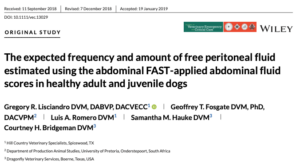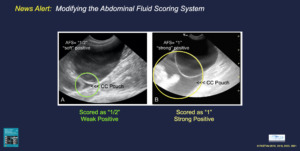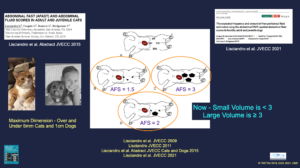
Our AFAST®-applied Fluid Scoring System’s “Small Volume and Large Volume Bleeder/Effusion Principle” has been updated!

The AFAST®-applied Fluid Scoring System has been modified based on some more recent clinical research published as abstracts in cats and dogs and then as a formal manuscript in dogs (Lisciandro et al. JVECC 2021). This is an important change for assessing both hemorrhagic and non-hemorrhagic effusions in dogs and cats but also may be applied to other species. The AFAST®-applied Fluid Scoring System now has a “weak positive” and “strong positive” model with “weak positives” scored as “1/2” and “strong positives” scored as a “1.”
There are 2 ways that we illustrate this modification and update – 1) the visual system and 2) the absolute measurements of maximum dimension to differentiate a “weak positive” from a “strong positive.” With this updated AFAST®-applied Fluid Scoring System, “small volume” is defined as less than three (<3) and “large volume” is defined as greater than or equal to three (≥3).

Figure. The Visual “Weak Positive” versus “Strong Positive.”

Figure. The Modification Better Categorizes “Small” versus “Large Volume” Bleeder-Effusion. Note that in C) there is a true large volume of “3” compared to B) with our new system that is a small volume of “1.5” that would not be differentiated using our original system (Lisciandro et al. JVECC 2009).

Figure. The AFAST®-applied Fluid Scoring System for Tracking Patients – worsening (increasing abdominal fluid score, AFS), or improving/resolving (decreasing abdominal fluid score, AFS), or static (no change in AFS). Veterinarians have a huge advantage over our physician counterparts did you not use a fluid scoring system routinely in people.
FASTVet 48-hour Bleeding Rule. EXPECT dogs and cats (and likely other species) to resorb the blood in their abdominal cavity within 48-hours if bleeding has ceased and coagulopathy when present has been corrected through author experience. No studies to the author’s knowledge have published this information but it serves as a good rule of thumb.
See our FASTVet Chart for the Bleeding Patient and Characterizing Effusions!
gl/GL 4-3-2023




